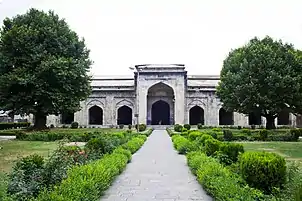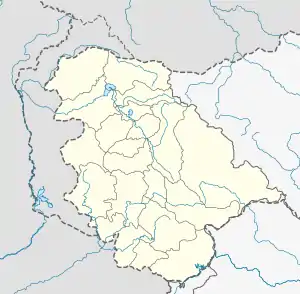Pathar Mosque
Pathar Mosque, known locally as Naev Masheed (Kashmiri: / ˈnəw ˌməʃiːd̪ /), is a Mughal era stone mosque located in the old city of Srinagar, in the Indian state of Jammu and Kashmir. It is located on the left bank of the River Jhelum, just opposite the shrine of Khanqah-e-Moula.[1] It was built by Mughal Empress Noor Jehan, the wife of emperor Jehangir, in 1623, for Shi’a Muslim Population.[2] Soon after its construction, the mosque was declared unfit for prayers and was used instead for non-religious purposes.[3] The structure was reconverted into a mosque in the early 1930s.[lower-alpha 1] The mosque has some distinct features that separate it from the rest of the mosques in the Kashmir Valley. Unlike other mosques, it does not have the traditional pyramidal roof. Furthermore, the mosque has nine mehraabs (arches), with the central one being larger than the others.[4][5]
| Pathar Mosque | |
|---|---|
 | |
| Religion | |
| Affiliation | Islam |
| District | Srinagar |
| Region | Kashmir Valley |
| Status | active |
| Location | |
| Location | Srinagar, India |
| State | Jammu and Kashmir |
 Shown within Jammu and Kashmir  Pathar Mosque (India) | |
| Geographic coordinates | 34°05′31″N 74°48′21″E |
| Architecture | |
| Completed | 1623 |
| Specifications | |
| Length | 180 ft (55 m) |
| Width | 51 ft (16 m) |
References
- The reconversion happened in the aftermath of communal riots in 1931, though earlier attempts were made in the 1910s.[3]
- Lawrence, W.R., The Valley of Kashmir, p. 37, at Google Books
- "Pathar Masjid-Kashmir Tourism".
- Rai, Mridu (2018), "To 'Tear the Mask off the Face of the Past': Archaeology and Politics in Jammu and Kashmir", in Chitralekha Zutshi (ed.), Kashmir: History, Politics, Representation, Cambridge University Press, pp. 39–41, ISBN 978-1-107-18197-7
- Feisal Alkazi, Srinagar: An Architectural Legacy, p. 91, at Google Books
- "A Desecrate Mosque".